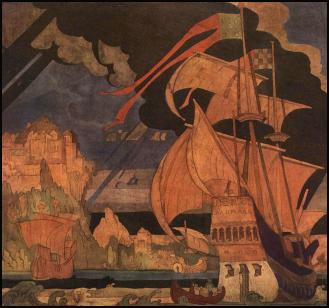
|
There was a certain hierarchy on board of a pirate ship, to determine the most important functions and the line of command:
Captain:
The captain of a pirate ship had to possess the qualities of leadership and courage. Generally chosen for his daring and dominating character, a pirate captain often was admired for his cruelty and destructiveness. A captain's power was absolute in time of chase or action, and he could discipline anyone who disobeyed his orders. He also had life and death power over anyone taken prisoner.
Quartermaster:
The quartermaster came next after the captain in exercising authority over the pirate crew; he was in charge of the men when the ship was not in action. He could punish the men for insubordination and arbitrated minor disputes among the men. The quartermaster usually led the attack and was the first to board the vessel. He was also in charge of food and water supplies. The quartermaster also assisted in numerous tasks, including attending to the binnacle (box housing the compass), steering the ship, and navigational duties.
|
Ship's Master (Pilot):
The ship's master was an officer responsible for the sailing of the ship. He had to be a specialists in navigation and pilotage. He directed the course and provide himself with maps and instruments necessary for navigation.
Boatswain:
The boatswain supervised the maintenance of the vessel and its supplies of naval stores (tar, pitch and tallow, spare sails, etc.). He was responsible for inspecting ships, sails and rigging each morning, and reporting their state to the captain. The boatswain was also in charge of all deck activities, including weighing and dropping anchor, and handling of the sails.
Sailing Master:
The sailing master was in charge of navigation. Of course, since charts were often inaccurate or nonexistent, his job was a difficult one. Many sailing masters had been forced into pirate service.
|

|

|
Master Gunner:
The master gunner was responsible for the ship's guns and ammunition. This included sifting the powder to keep it dry and prevent it from separating, insuring the canon balls were kept free of rust, and all weapons were kept in good repair.
Mate:
The Mate took care of the fitting out of the vessel, and examined whether it is sufficiently provided with ropes, pulleys, sails, and all other rigging necessary for the voyage. At the departure he took care of hoisting the anchor, and during the voyage he checked the tackle once a day. If he observed anything amiss, he acquainted the ship's master. Arriving at a tort, the mate caused the cables and anchors to be repaired, and took care of the management of the sails, yards and mooring of the ship. In case of absence or sickness of the ship's master, the mate commanded in his place.
|
|